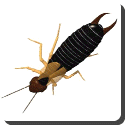 Earwig — Earwig is the common name given to the insect order Dermaptera characterized by membranous wings folded underneath short leathery forewings (hence the literal name of the order—“skin wings”). The abdomen extends well beyond the wings, and frequently, though not always, ends in a pair of forceps-like cerci. With about 1,800 recorded species in 10 families, the order is relatively small among Insecta. Earwigs are, however, quite common globally. There is no evidence that they transmit disease or otherwise harm humans or other animals, despite their nickname pincher bug.
Earwig — Earwig is the common name given to the insect order Dermaptera characterized by membranous wings folded underneath short leathery forewings (hence the literal name of the order—“skin wings”). The abdomen extends well beyond the wings, and frequently, though not always, ends in a pair of forceps-like cerci. With about 1,800 recorded species in 10 families, the order is relatively small among Insecta. Earwigs are, however, quite common globally. There is no evidence that they transmit disease or otherwise harm humans or other animals, despite their nickname pincher bug.
Earwig may also be used as a verb to mean: “to fill the mind with prejudice by insinuations” or “to attempt to influence by persistent confidential argument or talk”.
The name earwig comes from Old English eare “ear” and wicga “insect”. It is related to the fanciful notion that earwigs burrow into the brains of humans through the ear and therein lay their eggs. This belief, however, is false. Nevertheless, being exploratory and omnivorous, earwigs probably do crawl into the human ear; even if they are only looking for a humid crevice in which to hide, such behavior provides a memorable basis for the name.
Earwigging – also known as eavesdropping – means to overhear another’s conversation.
While earwigs can be considered in some ways a beneficial part of the garden, especially when they prey on other insects, they can become a nuisance because of their habit of hiding within leaves and feeding on soft plant tissues. Since they prefer cool, moist places, a rolled up damp newspaper placed where earwig activity is suspected can be effective in collecting them. The newspaper can then either be discarded or shaken out. Placing diatomaceous earth in key spots around the home (bathroom, baseboards, window frames) can be a long-term repellent.
Another method of removing earwigs is by utilizing their attraction to vegetable oil. Putting vegetable oil in a pie tin and burying it up to the rim of the tin is an effective way of capturing them. Another effective method of earwig control is to take steps to control the population before they hatch by removing rotting underbrush and spraying with commercially available insecticidal nematodes, which invade the earwigs in their nymphal stage and infect them with a lethal bacterium.
 Kids Portal For Parents India Kids Network
Kids Portal For Parents India Kids Network
